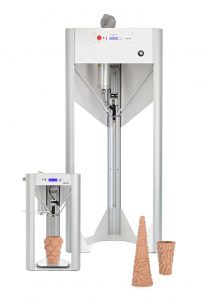 Contemporary and pop art during “Cèramica”, in the central piazza della Libertà of Montelupo Fiorentino. During these days, the artist Andrea Salvatori has exhibited the “Grande testone” (The Big Head) a large reproduction of Michelangelo’s David head.
Contemporary and pop art during “Cèramica”, in the central piazza della Libertà of Montelupo Fiorentino. During these days, the artist Andrea Salvatori has exhibited the “Grande testone” (The Big Head) a large reproduction of Michelangelo’s David head.
In order to achieve this result Mr. Salvatori has asked for help to WASP, the digital manufacturing center in Massa Lombarda (RA), an innovative production process for the ceramic world based on a scanning, modeling and 3D printing process. This is a totally new way of interpreting the ceramic process never seen before, that confirms, once again, the great attention of the Ravenna company for the clay as the best material in LDM (Liquid Deposition Modeling) process.
The new WASP ceramic 3D printers
3D printing of clay or other dense fluid materials is today a topic research of international interest in the world of additive manufacturing. In these days WASP has officially launched two new printers that can be used for all ceramic materials. They are the DeltaWASP 2040 Clay and the DeltaWASP 40100 Clay. Precise and fast, with a clean design and compact dimensions, they are open on three sides to allow interaction during the printing process.
How to make a large ceramic sculpture with innovative techniques
In the case of the David, created by Salvatori, thanks to the speed of acquisition and the amount of data collected by the 3D scanner, complex and detailed structures were detected, reproducing faithfully, quickly and accurately the object. Through 3D modeling software the file is graphically improved and thought on purpose for the additive process. Starting from the original sculpture model, 16 elements were divided and turned into molds for the hand molding of the ceramic sculpture. To these pieces a fixing system, necessary to recompose the figure in its entirety, was addeed.
Thanks to the DeltaWASP 3MT Industrial with pellet extruder, all the 16 elements have been realized with great precision and speed. For the printing, plastic materials in granules was used, cheaper and more versatile for jobs of this size. Subsequently, the artist plastered the molds, obtaining an extremely complex forming process, in a short time and with a totally innovative method. Once obtained the casts for the realization of the sculpture, the artist has passed to the hand molding of the 16 components, immediately ready for the execution of the finished object. From this type of shape it is possible to obtain a certain number of copies, identical to the original model.
Subscribe to our Newsletter
3DPResso is a weekly newsletter that links to the most exciting global stories from the 3D printing and additive manufacturing industry.






















